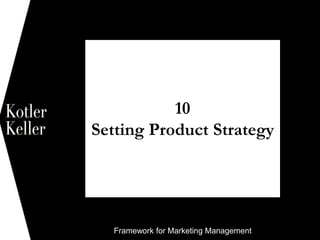More Related Content
Similar to Kotler framework 5e_10_sppt (20)
More from Nate Wildes (12)
Kotler framework 5e_10_sppt
- 2. Chapter Questions
What are the characteristics of products and
how do marketers classify products?
How can companies differentiate products?
How can a company build and manage its
product mix and product lines?
Copyright © 2011 Pearson Education, Inc. Publishing as Prentice Hall 10-2
- 3. Chapter Questions
How can companies use packaging, labeling,
warranties, and guarantees as marketing
tools?
What strategies are appropriate for new
product development and through the product
life cycle?
Copyright © 2011 Pearson Education, Inc. Publishing as Prentice Hall 10-3
- 4. Copyright © 2011 Pearson Education, Inc. Publishing as Prentice Hall 10-4
What is a Product?
A product is anything that can be offered to
a market to satisfy a want or need, including
physical goods, services, experiences,
events, persons, places, properties,
organizations, information, and ideas.
- 5. Figure 10.1 Five Product Levels
Copyright © 2011 Pearson Education, Inc. Publishing as Prentice Hall 10-5
- 6. Copyright © 2011 Pearson Education, Inc. Publishing as Prentice Hall 10-6
Product Classification Schemes
Durability
Tangibility
Use
- 7. Copyright © 2011 Pearson Education, Inc. Publishing as Prentice Hall 10-7
Durability and Tangibility
Nondurable goods
Durable goods
Services
- 8. Copyright © 2011 Pearson Education, Inc. Publishing as Prentice Hall 10-8
Consumer Goods Classification
Convenience
Shopping
Specialty
Unsought
- 9. Copyright © 2011 Pearson Education, Inc. Publishing as Prentice Hall 10-9
Industrial Goods Classification
Materials and parts
Capital items
Supplies/business services
- 10. Product Differentiation
Product form
Features
Customization
Performance
Conformance
Durability
Reliability
Repairability
Style
Copyright © 2011 Pearson Education, Inc. Publishing as Prentice Hall 10-10
- 11. Copyright © 2011 Pearson Education, Inc. Publishing as Prentice Hall 10-11
Service Differentiation
Ordering ease
Delivery
Installation
Customer training
Customer consulting
Maintenance and repair
Returns
- 13. Copyright © 2011 Pearson Education, Inc. Publishing as Prentice Hall 10-13
Line Stretching
Down-Market Stretch
Up-Market Stretch
Two-Way Stretch
- 14. Copyright © 2011 Pearson Education, Inc. Publishing as Prentice Hall 10-14
Product-Mix Pricing
Product-line pricing
Optional-feature pricing
Captive-product pricing
Two-part pricing
By-product pricing
Product-bundling pricing
- 16. Copyright © 2011 Pearson Education, Inc. Publishing as Prentice Hall 10-16
What is the Fifth P?
Packaging, sometimes called the 5th P,
is all the activities of designing and
producing the container for a product.
- 17. Copyright © 2011 Pearson Education, Inc. Publishing as Prentice Hall 10-17
Factors Contributing to the
Emphasis on Packaging
Self-service
Consumer affluence
Company/brand image
Innovation opportunity
- 18. Copyright © 2011 Pearson Education, Inc. Publishing as Prentice Hall 10-18
Packaging Objectives
Identify the brand
Convey descriptive and persuasive
information
Facilitate product transportation and
protection
Assist at-home storage
Aid product consumption
- 21. Copyright © 2011 Pearson Education, Inc. Publishing as Prentice Hall 10-21
Ways to Find Great New Ideas
Run informal sessions with customers
Allow time off for technical people to putter on
pet projects
Make customer brainstorming a part of plant
tours
Survey your customers
Undertake “fly on the wall” research to
customers
- 22. Copyright © 2011 Pearson Education, Inc. Publishing as Prentice Hall 10-22
More Ways to Find Great Ideas
Use iterative rounds with customers
Set up a keyword search to scan trade
publications
Treat trade shows as intelligence missions
Have employees visit supplier labs
Set up an idea vault
- 23. Copyright © 2011 Pearson Education, Inc. Publishing as Prentice Hall 10-23
Drawing Ideas from Customers
Observe customers using product
Ask customers about problems with products
Ask customers about their dream products
Use a customer advisory board or a brand
community of enthusiasts to discuss product
- 24. Demand-First Innovation and
Growth (DIG) Framework
Copyright © 2011 Pearson Education, Inc. Publishing as Prentice Hall 10-24
Demand Landscape
Opportunity Space
Strategic Blueprint
- 25. Copyright © 2011 Pearson Education, Inc. Publishing as Prentice Hall 10-25
Idea Generation:
Creativity Techniques
Attribute listing
Forced relationships
Morphological analysis
Reverse assumption analysis
New contexts
Mind mapping
- 26. Figure 10.3 Product and
Brand Positioning
Copyright © 2011 Pearson Education, Inc. Publishing as Prentice Hall 10-26
- 27. Copyright © 2011 Pearson Education, Inc. Publishing as Prentice Hall 10-27
Concept Testing
Communicability and believability
Need level
Gap level
Perceived value
Purchase intention
User targets, purchase occasions,
purchasing frequency
- 28. Copyright © 2011 Pearson Education, Inc. Publishing as Prentice Hall 10-28
Prototype Testing
Alpha testing
Beta testing
Rank-order method
Paired-comparison method
Monadic-rating method
Market testing
- 29. Consumer Goods Market Testing
Sales-Wave Research
Simulated Test Marketing
Controlled Test Marketing
Test Markets
Copyright © 2011 Pearson Education, Inc. Publishing as Prentice Hall 10-29
- 30. Copyright © 2011 Pearson Education, Inc. Publishing as Prentice Hall 10-30
Test Market Decisions
How many test cities?
Which cities?
Length of test?
What information to collect?
What action to take?
- 31. Copyright © 2011 Pearson Education, Inc. Publishing as Prentice Hall 10-31
What is Adoption?
Adoption is an individual’s decision to
become a regular user of a product.
- 32. Copyright © 2011 Pearson Education, Inc. Publishing as Prentice Hall 10-32
Stages in the Adoption Process
Awareness
Interest
Evaluation
Trial
Adoption
- 34. For Review
What are the characteristics of products and
how do marketers classify products?
How can companies differentiate products?
How can a company build and manage its
product mix and product lines?
Copyright © 2011 Pearson Education, Inc. Publishing as Prentice Hall 10-34
- 35. Also For Review
How can companies use packaging, labeling,
warranties, and guarantees as marketing
tools?
What strategies are appropriate for new
product development and through the product
life cycle?
Copyright © 2011 Pearson Education, Inc. Publishing as Prentice Hall 10-35

